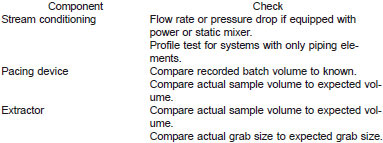ASTM D4177 Standard Practice for Automatic Sampling of Petroleum and Petroleum Products
16. Acceptance Tests
16.1 Testing is recommended to confirm that a sampling system is performing accurately. Annex A3 outlines methods for testing samplers that are used for the collection of S&W or free water samples. The test methods fall in two general categories; Total System Testing and Component Testing.
16.2 Total System Testing - This test method is a volume balance test where tests are conducted for known amounts of water. It is designed to test the total system including the laboratory handling and mixing of sample. Two procedures are outlined. One involves only the sampler under test, the other utilizes an additional sampler to measure the baseline water.
16.3 Component Testing - This test method involves testing individually the components that comprise a sampling system. Where applicable, some of the component tests may be conducted prior to installation of the total system. Components to be tested include:
16.3.1 Probe/extractor,
16.3.2 Profile (for stream conditioning),
16.3.3 Special flow meter, and
16.3.4 Primary sample receiver and mixer.
16.3.5 If a system design has been proven by testing, subsequent systems of the same design (for example, LACT Units), including piping configuration and operated under the same or less criterial conditions (that is, higher flow rate, higher viscosity, lower water content, etc.) need not be tested. Once a system or system design has been proven, the following checks can be used to confirm system reliability:Fig. 9

16.3.6 Portable sampling systems can be tested by the component testing method except for proper stream conditioning. To compensate for this, the performance test for each operation has been designed to evaluate the operation of the sampler. This is shown in Annex A5.
16.4 Requirements for Acceptability - Testing by either the component or total system method requires that two out of three consecutive sets of test data repeat within the limits shown in Annex A3.



